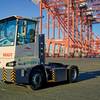U.K.'s Liverpool Bay Dredging Secret Discovered
New research tracking the movement of dredged sediment around Liverpool Bay could save millions of pounds in dredging costs.
Each year, sediment must be dredged from the port and deposited elsewhere to maintain access for commercial vessels. But according to the new study by scientists at the National Oceanography Center in Liverpool, the dredged material appears back in the port again within just a few weeks of its removal, carried by sea currents.
The team used computer models to predict the movement of a particle of dredged material once it had been deposited in the bay.
“It's just like the computer models they use to predict the weather,” said Dr. Alex Souza of the Natural Environment Research Council’s (NERC) National Oceanography Centre. “For the weather they track a balloon; here we are tracking a particle of sediment.”
Previous models hadn't taken into account the differences in density between fresh water from the river and salty seawater. Those differences drive currents which, in turn, affect the movement of the dredged sediment. The costs of dredging are not just economic. Concern has also been expressed about the disturbance of contaminated materials and the damage they could cause to the environment.
Dr. Souza and his team are working with the Centre for Environment, Fisheries & Aquaculture Science (CEFAS) to look for areas within the Mersey Estuary where the material could be safely disposed. “The money saved could be in the millions of pounds,” he said. “Obviously, repeatedly dredging the same material is costing a lot of money, but the savings in environmental costs could be even greater.”













